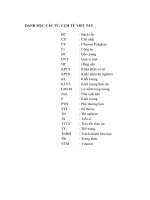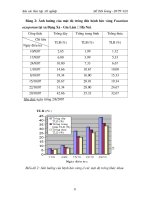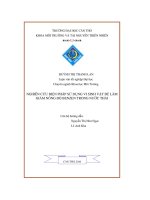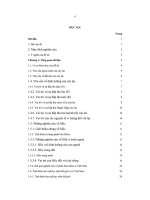Đề tài nước ngoài làm nghiên cứu luận án thạc sĩ, tiến sĩ
Bạn đang xem bản rút gọn của tài liệu. Xem và tải ngay bản đầy đủ của tài liệu tại đây (113.88 KB, 13 trang )
các đề tài nghiên cứu và làm luận án thác sỹ, tiến sỹ
( lấy tù internet 19-2-2005)
nguyễn viết trung
Research by ROSE Students
Below, the titles of MSc Dissertation and Individual Study projects carried out by our
students are listed. As expected, the range of themes under investigation is quite
broad; a natural reflection of the multidisciplinary character of the ROSE School. For
further information on each one of these projects, click on the titles listed below.
MSc dissertations & Individual Studies - Year 2004
Displacement-based design of continuous concrete bridges under transverse
seismic excitation
Bidirectional modelling of high-damping rubber bearings
Record selection for nonlinear seismic analysis of structures
Seismic vulnerability of masonry arch bridges
Dynamic behaviour of reinforced concrete frames designed with direct
displacement-based design
Rocking isolation of bridge piers resting on spread foundations
Displacement capacity of reinforced concrete columns with limited shear resistance
Probabilistic implementation of a mechanics-based procedure for seismic risk
assessment of classes of R.C. buildings
Seismic analysis of the structure of an underground railway station including SSI
Equivalent viscous damping equations for direct displacement-based design
An Isogeometric Analysis Approach for the Study of Structural Vibrations
Design of a dynamic and pseudo-dynamic testing facility
Effects of column base behaviour on the overall response of steel moment frames
MSc dissertations & Individual Studies - Year 2003
Seismological criteria for selecting and scaling real accelerograms for use in
engineering analysis and design
FRP seismic retrofit of square hollow seimic bridge piers
3D pushover of irregular reinforced concrete buildings
Shape-memory alloy devices in earthquake engineering: mechanical properties,
constitutive modelling and numerical simulations
Periods of vibration for displacement-based assessment of RC buildings
Comparative parametric study on normal and buckling restrained steel braces
Seismic hazard assessment of the historical site of Jam and stability analysis of the
minaret
Limitations and performances of different approaches for seismic assessment of
existing buildings
A simplified mechanics-based procedure for the seismic risk assessment of
unreinforced masonry buildings
MSc dissertations & Individual Studies - Year 2002
Explorative study of scatter in strong-motion attenuation relationships for
application to seismic hazard assessment
Displacement-based seismic analysis for out-of-plane bending of unreinforced
masonry walls
Dynamic amplification of bending moments and shear forces in cantilever walls
A simplified deformation-based method for seismic vulnerability assessment
Does liquefaction protect overlying structures from ground shaking?
Fragility analysis of reinforced concrete structures using a response surface
approach
The current limitations of displacement based design
Cyclic soil plasticity
Current Research Topics
The following list includes a succinct, and surely incomplete, sample of the topics of
research currently offered to students. It is noted that a strong experimental
component is present in a number of investigation areas and that the vast majority
of the projects are carried out within the scope of National and International research
networks. Further details may be obtained by contacting the School Director:
Applied mechanics and advanced computer modelling
Development of non-isotropic and/or inelastic constitutive equations for innovative
materials, in large deformation regime
Development of finite element technologies for nonlinear static and/or dynamic
analysis of structures
Experimental and analytical work on reinforced concrete structures
Assessment and retrofitting of beam-column and flat slab-column joints
Assessment, repair and strengthening of reinforced concrete buildings
Assessment of existing pre-cast concrete buildings
Vulnerability evaluation, at urban scale, of existing reinforced concrete buildings
(using mechanical or mechanical-empirical approaches)
Experimental and analytical work on reinforced concrete bridges
Assessment of frame and arch bridges
Assessment, repair and strengthening of hollow bridge piers
Carbon fibre strengthening of bridge slabs
Isolation systems for bridges
Relevance of re-centering capacity of isolating devices
Experimental and analytical work on masonry arch bridges
Interaction between infill material and parapet walls in relation with a possible out-
of-plane collapse
Influence of non-synchronous input or soil incoherency
Relevance of vertical acceleration in relation to arch-pier interaction, and its
potential for damage to the arch structure
Experimental and analytical work on masonry buildings
Performance-based assessment of existing masonry buildings (based on pushover
analysis methods)
Out-of-plane response and collapse mechanisms of masonry walls
Seismic assessment of historical structures
Engineering seismology
Regional estimation of macro-seismic attenuation in Italy
Estimation of local amplification effects using historical MCS intensities
Estimation of earthquake recurrence laws for seismic hazard analysis
Catalogue incompleteness and its effects on seismic hazard
Experimental and Numerical Facilities
Structural Laboratory
The School makes use of the structural laboratory of the University of Pavia, the
largest University testing facility in Italy. The total area inside the laboratory exceeds
1500 m2. Reaction structures include a strong floor of approximately 400 m2, with a
capacity of approximately 500 kN/m2, and four reaction walls, with a reaction
capacity of approximately 600 kN each, at 8 m of height.
Equipment includes two small shaking tables (100 kN capacity), two MTS dynamic
actuators (500 kN capacity), four screw jacks (500 kN capacity), more than two
hundred displacement transducers, twenty digital accelerometers and two laser
velocity interferometers. The data acquisition system is fully consistent with the
available instruments thanks to the continuous use of the most advanced
hardware/software test processing tools. The laboratory is fully equipped with
standard material testing machines and with a workshop for in-house preparation of
all necessary test-rig components.
Computer Labs
The School has its own numerical facility, in addition to the large University system.
The School system includes a network of 15 workstations, fully interacting with a
local server connected through optical fibres to the University system. Available
software includes a number of commercial structural computer codes, such as Adina
and SAP2000, in addition to programmes developed or modified locally, such as
Feap, Ruaumoko or Drain2D.
FRP seismic retrofit of square hollow seimic bridge piers
Student: S. Peloso
Supervisor: Dr. A. Pavese
Abstract
Over the past 20 years, fibre reinforced polymers (FRP) have been increasingly
employed in the upgrade and repair of concrete and masonry structures in seismic
prone countries, with extensive research programmes being carried out worldwide,
focusing primarily on the improvement of the seismic capacity of bridge piers.
However, the majority of such research has not considered the case of square hollow
section bridge piers. These are very common in Europe, featuring also a construction
date between the ‘50s and ‘70s, when seismic zones were often not recognized,
resulting thus in piers designed for gravity loads alone. As a consequence, these
bridge piers call now for large strength and ductility enhancements in order to meet
the prerequisites of modern earthquake resistant regulations.
In addition, a number of such bridges have been subjected to earthquakes resulting,
in some instances, in failure mechanisms due to: shear, combined flexure/shear and
insufficient lap splice. It is thus clear that the development of efficient structural
intervention methods to be applied in the repair and strengthening of square hollow
bridge piers is of great importance and relevance, in particular within the framework
of European transport infrastructures.
Within the scope of the current research, quasi-static cyclic tests were performed
with increasing levels of drift applied to scaled specimens of FRP retrofitted piers,
taking trace of the force-displacement diagram and flexural and shear deformations.
Further, the effect of FRP intervention in the level of section confinement, the
efficiency of the anchorage, the energy dissipation, the achieved ductility and
horizontal strength of the retrofitted piers were all thoroughly scrutinised, through
comparison with the response of previously tested specimens without FRP
application. Finally, the experimental results were also employed to assess the
adequacy of currently available design formulae, calibrated through experiments on
solid section piers, in the prediction of the capacity of retrofitted hollow bridge piers.
You may download (4700 kB) a digital version of this MSc dissertation here.
Shape-memory alloy devices in earthquake engineering:
mechanical properties, constitutive modelling and numerical
simulations
Student: Davide Fugazza
Supervisors: Prof. F. Auricchio, Dr. A. Pavese, Dr. L. Petrini
Abstract
Shape-memory alloys (SMAs) are a class of solids showing mechanical properties not
present in materials usually employed in engineering. SMAs have the ability to
undergo reversible micromechanical phase transition processess changing their
cristallographic structure. This capacity results in two major features at the
macroscopic level which are the superelasticity and the shape-memory effect.
Due to these unusual characteristics, materials made of SMAs lend themselves to
innovative applications in many scientific fields ranging from biomedical devices,
such as stents or orthodontic archwires, to apparatus for the deployment and control
of space structures, such as antennas and satellites.
Experimental and numerical investigations have also shown the possibility of using
such smart new materials in vibration control devices. In particular, they seem to be
an effective mean of improving the response of buildings and bridges subjected to
seismic loads.
Despite the availability of a large number of mechanical tests conducted by many
authors, few works deal with their constitutive modelling for earthquake engineering
applications. Also, their dynamic response under high-frequency loading conditions
would need further studies. As a consequence, the main aim of the present work is
to cover this lack of information.
The main objectives of the present dissertation are the following:
- To present and comment the mechanical properties of SMA materials with
emphasis on their response under dynamic loading conditions.
- To study the constitutive modelling of SMAs for seismic applications.
- To implement a robust uniaxial constitutive model for superelastic SMAs.
- To understand the influence of the SMA's mechanical properties on their dynamic
behavior through parametric analyses.
You may download (1600 kB) a digital version of this MSc dissertation here.
Periods of Vibration for Displacement-based Assessment of RC
Buildings
Student: Helen Crowley
Supervisors: Dr. R. Pinho
Abstract
Simple empirical relationships are available in many design codes to relate the height
of a building to its fundamental period of vibration. These relationships have been
realized for force-based design and so produce conservative estimates of period such
that the lateral shear force will be conservatively predicted from an acceleration
spectrum. Where assessment of a structure is concerned, it is the displacement
demand that gives an indication of the damage that can be expected, this
displacement would be underestimated with the use of the aforementioned period –
height formulae. Furthermore, the period of vibration of interest in assessment is the
yield period, which is calculated using the yield stiffness, also often referred to as the
cracked or elastic stiffness. The derivation of a yield period – height formula for use
in displacement-based assessment of European buildings is thus the focus of this
dissertation. Analytical fibre element models of RC frames of varying height have
been developed and the yield period has been sought using eigenvalue, pushover
and dynamic analyses.









